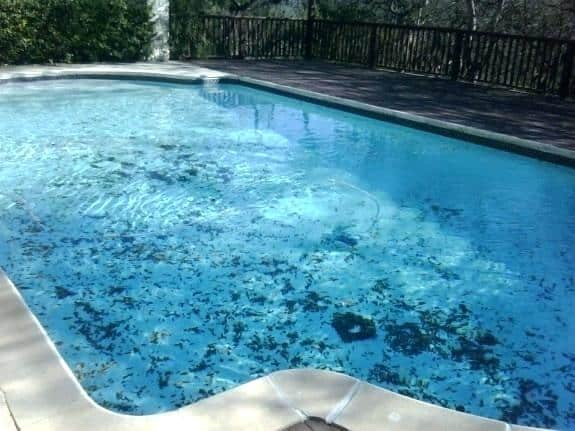
Black algae can be daunting, it’s not fun. Getting rid of black algae can be a challenging task but by following these 11 steps, you can tackle this daunting task.
In this article, we go over what black algae is, what it looks like, what causes it and why you need to get rid of it right away rather than later.
What is Black Algae?
Black algae are single-celled organisms that grow in large colonies. They grow on swimming pool surfaces such as concrete, gunite, and plaster. They show up in the form of black spots. It is notorious for settling into corners, steps, and other hard-to-reach areas, and it thrives in both sun and shade.
What Does Black Algae Look Like?
If you know what black algae looks like you can be on the lookout so you can catch it a lot sooner which will make tackling the task much more straightforward.
Black algae appears in the form of distinct, black spots or splotches. It technically has a shade of black when in your pool, but black algae is a very dark shade of green.
What Causes Black Algae?
Several common causes of black algae include:
- Black algae spores getting into your water
- Clogged or dirty filter
- Clogged or dirty skimmer basket
- Poor water maintenance (not running filter at least 8 hours)
- Unbalanced, chlorine levels
- Letting all of the above happen for a while
Basically, the conditions the black algae thrives in are poor pool maintenance or bad chemical balance. With that all being said, it is important to know the root causes of black algae.
Is Black Algae Dangerous?
Simply, yes. It can be if untreated. The awareness of this danger comes from the dangers of blue-green algae.
Cyanobacteria which is a division of microorganisms that is related to the bacteria blooms in natural bodies of water. It can kill organisms and animals that live in water that is blocked by sunlight or lack of oxygen.
Swimming in water with black algae can sometimes be enough to make you sick. If you accidentally drink the infected water the probability and severeness of the illness will increase. You can experience anything from nausea and stomach cramps to liver damage. Humans aren’t the only ones that can get sick as animals can get sick as well. If you see your dog take a drink from the pool, they could be in danger of becoming sick if the water is infected.
How to Get Rid of Black Algae
You are seconds away from learning how to remove black algae from your pool. But before you start, you will want to make sure you are prepared for the job. This way, you get the best results.
Before you try to get rid of black algae, here is what you will need:
- Pool shock treatment
- Chlorine tablets
- A pool brush and a pole
- Algaecide
- Regular pool chemicals (pH adjusters, alkalinity adjusters, and granular chlorine)
Here’s a step by step guide for removing black algae from your pool:
1. Clean and Sanitize Everything
Make sure to thoroughly clean and sanitize your tools so that way you don’t introduce any new bacteria or end up adding more algae. Scrub your tools with a chlorine solution and then spray them off.
Don’t forgot to clean all of your pool toys and throw all of the bathing suits in the washer and dryer. Quick trick, you can put your maintenance equipment in the pool so they way when you sanitize the pool, your maintenance equipment get sanitized too.
2. Clean Your Filters
You always want to clean your filters even if you can’t see black algae inside it. Refer to the owner’s manual for the best instruction when cleaning it. Sand and DE filters must be back-washed and rinsed several times to insure they are clean.
3. Scrub the Pool
You are going to want to use a nylon brush for the scrubbing all of the sides and the bottom of the pool. Do this until all the black algae are brushed away. You will need a wire brush or very stiff brush if you have a concrete or natural element pool. That will allow you to remove the algae’s protective layer which slow down the algae growth.
4. Scrub the Pool with Chlorine Tablets
Break one chlorine tablet in half and use the rough side to scrape the black algae spots that are difficult to remove with a brush. Don’t forget to wear gloves so you can remain safe. Scraping the affected areas with the chlorine tablet will help remove the protective layers of the algae and will expose the roots, which will allow the chlorine to kill them.
5. Shock Your Pool
Make sure you have a good shock treatment that way it will eliminate all the bacteria and stunt any growths in the pool. A super shock chlorine treatment would be perfect for this.
6. Add Granular Chlorine
This is an important step since it will make your pool safe for swimming again. Follow the manufactures instructions carefully but also pay extra close attention to the areas the had the algae. If you pool has any dark surfaces, you may want to skip this step as it can cause discoloration.
7. Add Algaecide
If you want black algae to be a thing of the past, you are going to want to add algaecide too. A standard bottle should be enough to treat up to 15,000-gallons of pool water. This will greatly help prevent any future outbreaks.
8. Run the Pump
You are going to want to wait 24 hours for this treatment to settle in, then you can run your pump for another 24 hours. Once you have done that you can resume your normal pump schedule. If you see your pool has a dark color, you need to immediately run the pump so the treatment does not discolor it.
9. Brush the Pool Again
After your first shock treatment, you will want to brush your pool 2-4 times a day and heavily concentrate on the areas that once previously had spotted the algae. Once again, the algae roots dig deep into the walls and it may appear it gone, so assume that it’s still there.
Shock your pool and brush it after 3-4 days has passed with the normal amount of chlorine treatment.
10. Clean the Filter Again
You will want to stay on the safe side by cleaning your filter after the treatment to help remove any unwanted residue left behind by the algae. Rinse the DE and filter several times just like you did before to remove all bacteria and organisms.
11. Constantly Check for Algae
Black algae can be very stubborn and you may spot some algae growth starting to appear in your pool. If you see any spots even if several weeks have passed, shock your pool and brush it again twice a day.
Now that you have been through the steps and successfully been able to get rid of the obnoxious black algae, you can enjoy swimming and relax in your pool once again.
You will want to keep up with your regular weekly pool maintenance such as brushing it down, check the chemistry levels, vacuuming it, and cleaning the filters weekly. You will want to keep running the pump daily to get rid of any unwanted items in the pool.
How to Prevent Black Algae
It’s great your pool is now clean but that does not mean you will not have to deal with black algae again. If you weren’t able to get rid of this time, be more aggressive with your treatment and you will get rid of it.
If you have a clean pool, you will definitely want to keep it algae free. To help you with that, you will need to:
- Wash all your swimsuits, toys and floats after you gone to the ocean
- Make to keep your pool water at the proper chemistry levels
- Brush and vacuum your pool regularly to keep your pool clean.
- Clean and sanitize anything that comes in contact with the pool such as pool equipment, pool toys and etc.
- Shock your pool weekly. Remember to add 1 pound for every 10,000 gallons of pool water. You can use an extra heavy chlorine treatment to make black algae the much harder to come back.
Keep in mind, stopping black algae from growing will always be better and easier than trying to get rid of it. Be regular with your cleanings and if you are struggling to keep up with, consider hiring pool service company to help you out.
Bottom Line
Now that you have been able to go through all the hard work to keep a clean pool. You can see how important is it to do preventive maintenance that way you can enjoy your pool more. If you have another unfortunate black algae problem don’t hesitate to use these steps again listed above.

